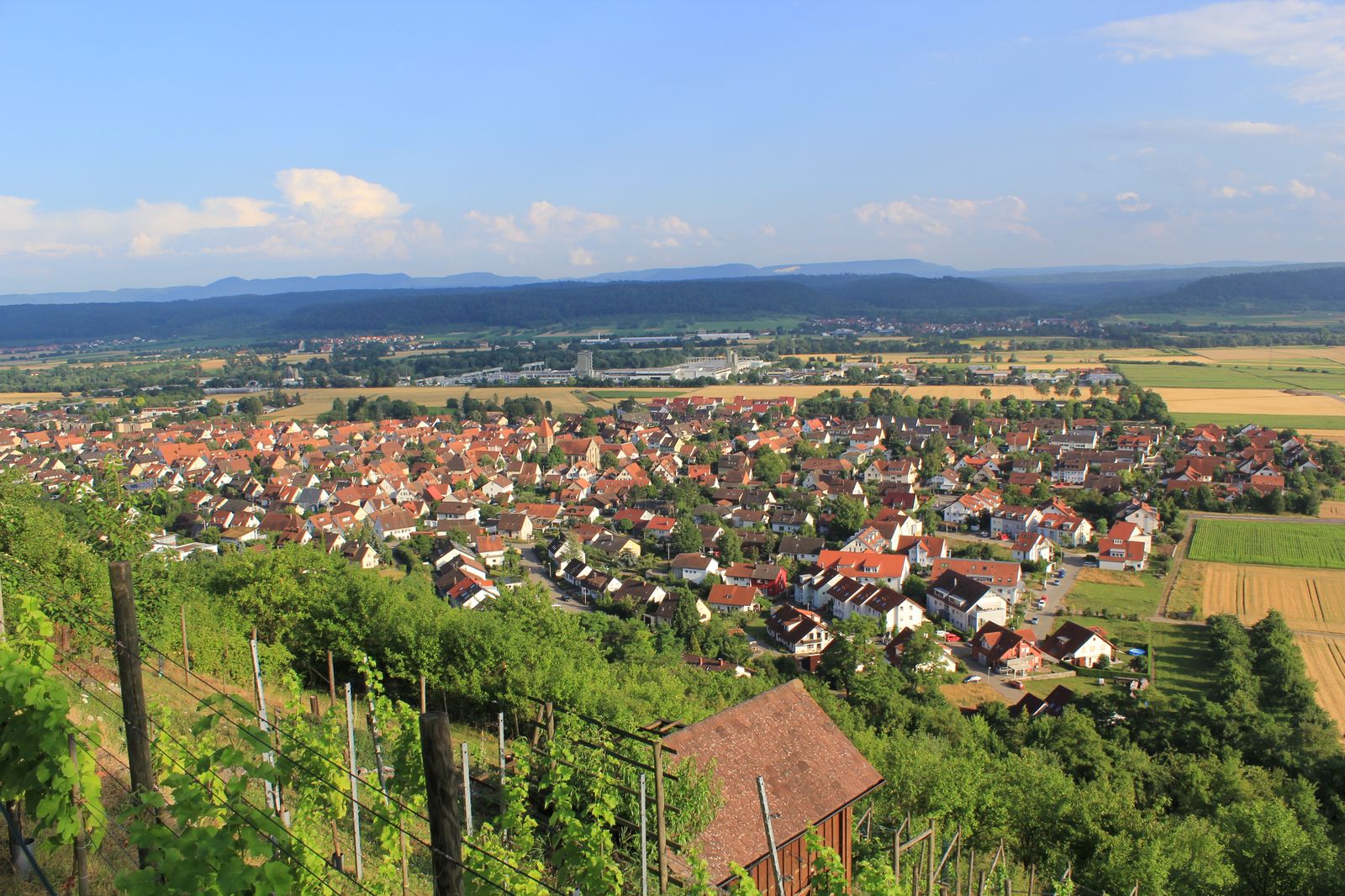|
Kiebingen
Kiebingen is a suburban district of Rottenburg am Neckar in the administrative district of Tübingen in Baden-Württemberg (Germany). Geography Kiebingen is located 3 km (1.9 mi) eastern from Rottenburg and 8 km (5 mi) western from Tübingen in the valley of the Neckar river. Extent The area of the district is 514 hectares. Thereof fall 60.1% upon agriculturally used area, 21.7% upon forest area, 14.7% upon settlement area and roads, 2.7% upon water extent and 0.8% upon other. Neighbour localities The territories of the following localities adjoin to Kiebingen, they are called clockwise beginning in the north: Wurmlingen, Hirschau, Bühl and Rottenburg (town), (all in the admin. district of Tübingen). Wurmlingen is also a suburb of Rottenburg, Hirschau and Bühl are suburbs of Tübingen. Wurmlingen and Hirschau are situated northern, Kiebingen and Bühl southern of the Neckar. Population Kiebingen has 2007 residents (31/01/08). It is the third ... [...More Info...] [...Related Items...] OR: [Wikipedia] [Google] [Baidu] |
Neckar
The Neckar () is a river in Germany, mainly flowing through the southwestern state of Baden-Württemberg, with a short section through Hesse. The Neckar is a major right tributary of the Rhine. Rising in the Schwarzwald-Baar-Kreis near Schwenningen in the ''Schwenninger Moos'' conservation area at a height of above sea level, it passes through Rottweil, Rottenburg am Neckar, Kilchberg, Tübingen, Wernau, Nürtingen, Plochingen, Esslingen, Stuttgart, Ludwigsburg, Marbach, Heilbronn and Heidelberg, before discharging on average of water into the Rhine at Mannheim, at above sea level, making the Neckar its 4th largest tributary, and the 10th largest river in Germany. Since 1968, the Neckar has been navigable for cargo ships via 27 locks for about upstream from Mannheim to the river port of Plochingen, at the confluence with the Fils. From Plochingen to Stuttgart, the Neckar valley is densely populated and heavily industrialised, with several well-known companies. Between ... [...More Info...] [...Related Items...] OR: [Wikipedia] [Google] [Baidu] |
Rottenburg Am Neckar
Rottenburg am Neckar (; until 10 July 1964 only ''Rottenburg''; Swabian: ''Raodaburg'') is a medium-sized town in the administrative district (''Landkreis'') of Tübingen in Baden-Württemberg, Germany. It lies about 50 kilometres (31 miles) southwest of the provincial capital Stuttgart and about 12 km (7 mi) southwest of the district town Tübingen. Rottenburg is the second-largest town of the district after Tübingen and makes up a secondary centre for the surrounding community. Since 1 May 1972, Rottenburg am Neckar has been a district town (''Große Kreisstadt''). Rottenburg agreed to an administrative collective with the municipalities of Hirrlingen, Neustetten and Starzach. Rottenburg is the seat of a Roman Catholic bishop, being the official centre of the diocese of Rottenburg-Stuttgart. Moreover, it has a college of church music and a university of applied sciences (German ''Fachhochschule''), specialising in forestry. Geography Rottenburg is divided int ... [...More Info...] [...Related Items...] OR: [Wikipedia] [Google] [Baidu] |
Lion-sur-Mer
Lion-sur-Mer (, literally ''Lion on Sea'') is a commune in the Calvados department in the Normandy region in northwestern France. Geography Lion-sur-Mer is located on the edge of the English Channel, more precisely on the '' Côte de Nacre'' (Mother of Pearl Coast), about North of Caen. The beach is made of fine sand and is bordered, to the west, by middle-sized cliffs. The town is served by 2 bus services : line No. 1 of the ''Bus Verts du Calvados'' and line No. 62 of Twisto. A ferry of Brittany Ferries links Ouistreham (5 km from Lion-sur-Mer) to Portsmouth in England. History * 6 June 1944 : The D-Day of the Battle of Normandy during World War II. British soldiers landed on the beach of Lion-sur-Mer which was a part of the Sword Beach sector. Population Sights * The beach, its promenade (''La digue'') and its villas from the beginning of the 20th century Image:Lion-sur-Mer Plage Est.jpg, To the East, the beach with the promenade (in the foreground, th ... [...More Info...] [...Related Items...] OR: [Wikipedia] [Google] [Baidu] |
Tübingen (district)
Tübingen is a ''Landkreis'' (district) in the middle of Baden-Württemberg, Germany. Neighboring districts are (from north clockwise) Böblingen, Reutlingen, Zollernalbkreis and Freudenstadt. History The district dates back to the ''Oberamt Tübingen'' in the state of Württemberg. In 1811 the ''Oberamt Rottenburg'' was created, and both were converted into districts in 1934. In 1938 most of the district Rottenburg as well as a few municipalities from the district Herrenberg and Reutlingen were added to the district Tübingen. In 1974 it was enlarged again when some municipalities from the dissolved district Horb were added. Geography The main river in the district is the Neckar. The landscapes covered by the district are called ''Oberer Gäu'' and ''Schönbuch''. Coat of arms The coat of arms show the banner (gonfalon) of the Counts of Tübingen. In contrast to the coat of arms of the city Tübingen, it is depicted on a spear. The red-and-white colors are chosen to represent ... [...More Info...] [...Related Items...] OR: [Wikipedia] [Google] [Baidu] |
Baden-Württemberg
Baden-Württemberg (; ), commonly shortened to BW or BaWü, is a German state () in Southwest Germany, east of the Rhine, which forms the southern part of Germany's western border with France. With more than 11.07 million inhabitants across a total area of nearly , it is the third-largest German state by both area (behind Bavaria and Lower Saxony) and population (behind North Rhine-Westphalia and Bavaria). As a federated state, Baden-Württemberg is a partly-sovereign parliamentary republic. The largest city in Baden-Württemberg is the state capital of Stuttgart, followed by Mannheim and Karlsruhe. Other major cities are Freiburg im Breisgau, Heidelberg, Heilbronn, Pforzheim, Reutlingen, Tübingen, and Ulm. What is now Baden-Württemberg was formerly the historical territories of Baden, Prussian Hohenzollern, and Württemberg. Baden-Württemberg became a state of West Germany in April 1952 by the merger of Württemberg-Baden, South Baden, and Württemberg-Hohenzollern. The ... [...More Info...] [...Related Items...] OR: [Wikipedia] [Google] [Baidu] |
Germany
Germany,, officially the Federal Republic of Germany, is a country in Central Europe. It is the second most populous country in Europe after Russia, and the most populous member state of the European Union. Germany is situated between the Baltic and North seas to the north, and the Alps to the south; it covers an area of , with a population of almost 84 million within its 16 constituent states. Germany borders Denmark to the north, Poland and the Czech Republic to the east, Austria and Switzerland to the south, and France, Luxembourg, Belgium, and the Netherlands to the west. The nation's capital and most populous city is Berlin and its financial centre is Frankfurt; the largest urban area is the Ruhr. Various Germanic tribes have inhabited the northern parts of modern Germany since classical antiquity. A region named Germania was documented before AD 100. In 962, the Kingdom of Germany formed the bulk of the Holy Roman Empire. During the 16th ce ... [...More Info...] [...Related Items...] OR: [Wikipedia] [Google] [Baidu] |
Tübingen
Tübingen (, , Swabian: ''Dibenga'') is a traditional university city in central Baden-Württemberg, Germany. It is situated south of the state capital, Stuttgart, and developed on both sides of the Neckar and Ammer rivers. about one in three of the 90,000 people living in Tübingen is a student. As of the 2018/2019 winter semester, 27,665 students attend the Eberhard Karls University of Tübingen. The city has the lowest median age in Germany, in part due to its status as a university city. As of December 31, 2015, the average age of a citizen of Tübingen is 39.1 years. The city is known for its veganism and environmentalism. Immediately north of the city lies the Schönbuch, a densely wooded nature park. The Swabian Alb mountains rise about (beeline Tübingen City to Roßberg - 869 m) to the southeast of Tübingen. The Ammer and Steinlach rivers are tributaries of the Neckar river, which flows in an easterly direction through the city, just south of the medieval old t ... [...More Info...] [...Related Items...] OR: [Wikipedia] [Google] [Baidu] |
Hectare
The hectare (; SI symbol: ha) is a non-SI metric unit of area equal to a square with 100-metre sides (1 hm2), or 10,000 m2, and is primarily used in the measurement of land. There are 100 hectares in one square kilometre. An acre is about and one hectare contains about . In 1795, when the metric system was introduced, the ''are'' was defined as 100 square metres, or one square decametre, and the hectare ("hecto-" + "are") was thus 100 ''ares'' or km2 (10,000 square metres). When the metric system was further rationalised in 1960, resulting in the International System of Units (), the ''are'' was not included as a recognised unit. The hectare, however, remains as a non-SI unit accepted for use with the SI and whose use is "expected to continue indefinitely". Though the dekare/decare daa (1,000 m2) and are (100 m2) are not officially "accepted for use", they are still used in some contexts. Description The hectare (), although not a unit of SI, i ... [...More Info...] [...Related Items...] OR: [Wikipedia] [Google] [Baidu] |
Wurmlingen (Rottenburg)
Wurmlingen () is a suburban district of Rottenburg am Neckar in the administrative district of Tübingen in Baden-Württemberg (Germany). It is famous for its chapel, located atop a hill, which is the subject of a famous poem by Ludwig Uhland. Geography Wurmlingen is located 4 km (2.5 mi) northeastern from Rottenburg and 8 km (5 mi) southwestern from Tübingen in valley of the Neckar. Extent The area of the district is 714 hectares. Thereof fall 68.6% upon agriculturally used area, 15.1% upon forest area, 15.1% upon settlement area and roads, 0.1% upon water expanse and 1.1% upon other. Neighbour localities The territories of the following localities adjoin to Wurmlingen, they are called clockwise beginning in the north: Unterjesingen, Hirschau, Rottenburg (Town), Wendelsheim. All bordering localities are in the administrative district of Tübingen. Unterjesingen and Hirschau are suburban districts of Tübingen Tübingen (, , Swabian: ''Dibenga'') is a ... [...More Info...] [...Related Items...] OR: [Wikipedia] [Google] [Baidu] |
Hirschau (Tübingen)
Hirschau is a village in Tübingen district in Baden-Württemberg, Germany. Since 1971, it is an outer district of the city of Tübingen. Hirschau has a population of 3297 (2020) on an area of 6.17 km2. It is the westernmost district of Tübingen. Hirschau lies to the north of the Neckar river, about 3 km to the east of Wurmlingen, which is a part of Rottenburg am Neckar, and about 6 km to the east of the town centre of Rottenburg am Neckar as well as to the west of the city centre of Tübingen. The highest point is the Spitzberg at 475 m above mean sea level. Unlike most of Tübingen, Hirschau is, like neighbouring Rottenburg, mostly Roman Catholic Roman or Romans most often refers to: *Rome, the capital city of Italy *Ancient Rome, Roman civilization from 8th century BC to 5th century AD *Roman people, the people of ancient Rome *'' Epistle to the Romans'', shortened to ''Romans'', a lette .... References {{DEFAULTSORT:Hirschau (Tubingen) Villages i ... [...More Info...] [...Related Items...] OR: [Wikipedia] [Google] [Baidu] |
Bühl (Tübingen)
Bühl is a village in the Tübingen district in Baden-Württemberg, Germany. Since 1971, it is an outer district of the city of Tübingen. Bühl has a population of 2 194 on an area of 6,41 km². It lies on the southern bank of the Neckar river, directly adjacent to the east to Kilchberg, 4 km to the east of Rottenburg am Neckar Rottenburg am Neckar (; until 10 July 1964 only ''Rottenburg''; Swabian: ''Raodaburg'') is a medium-sized town in the administrative district (''Landkreis'') of Tübingen in Baden-Württemberg, Germany. It lies about 50 kilometres (31 miles) s ... and about 6 km to the southwest of the inner city of Tübingen. {{DEFAULTSORT:Buhl (Tubingen) Villages in Baden-Württemberg Boroughs of Tübingen ... [...More Info...] [...Related Items...] OR: [Wikipedia] [Google] [Baidu] |






